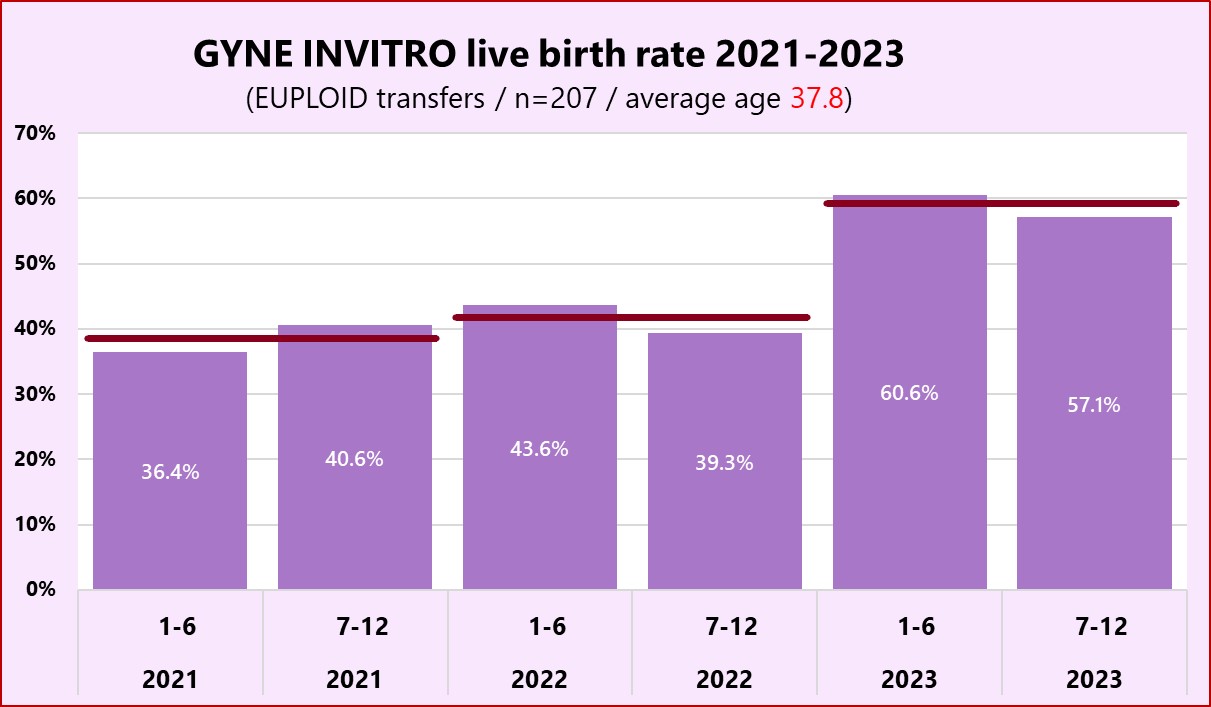


CLINIC GYNÉ INVITRO Michael Singer, M.D.
In 2023, dreams came true in our IVF program
What is success? Getting pregnant in short time and giving birth to a healthy singleton child. With this goal in mind, you are in good hands at our GYNE INVITRO team, because of our repeated and verifiable results at the absolute top of Swiss laboratories, and because we optimally exploit the new possibilities offered by the liberalised Swiss law since 2017. In 2023, we experienced another significant boost in treatment effectiveness, with 86 babies born or in advanced pregnancy, compared to 50-60 babies in earlier years.

The graph above shows live births and advanced pregnancies - the only outcome that counts for the treated couples. As an important quality feature, we transferred without exception only one embryo per transfer; starting in late 2022, we made sure that there is always a yellow body in thawing cycles, which reduces significantly both miscarriages and problems during later pregnancy. We deem it the main reason why live births increased from less than 40% in 2022 to above 50% in 2023.

The second graph above shows live births after transfer of genetically tested embryos (PGT-A). The success rates are clearly superior to the first graph, despite an average age of the women close to 38 years, and despite the fact that those embryos, without exception, were all biopsied, frozen and thawed. Aside from constant optimizations in the laboratory, we feel that the switch to thawing cycles with yellow body had a particularly positive effect - our rate of miscarriages with genetically tested embryos sank below 10% in 2023!
Swiss benchmarking
The Switzerland-wide benchmark via the compulsory and anonymous national IVF registry FIVNAT always lags some years behind, but proves our position at the absolute top of Swiss centres since 2015:
2019 ...

The bar graph above represents the anonymous compilation of 2019 success rates per IVF team, annotated by us. Every IVF team is told only his own figures, but can locate itself on the graph and is free to share its position with prospective patients. We gladly share our track record, having been again in the top three of Switzerland after 2015 und 2017, and having been again certified success rates clearly above Swiss national average (see yellow box: best success rate in thawing cycles - 53.1% compared to Swiss average of 37.7% - and second best in fresh cycles - 50.0% compared to 32.3%). We endorse the anonymity of the famous graph above (otherwise couples with poor prognosis could be turned away by many centres), but every couple is encouraged to inquire about certified success rates of a given IVF team.
In 2019, our team attained 50% pregnancies with fresh and 53% with frozen-thawed embryos. With pre-implantation testing, we recorded as much as 66% pregnancies despite a higher average female age of 38.5 years (this subgroup, which is important to us, has not been shown separately by FIVNAT yet).

The graph above shows the average number of embryos transferred per attempt. With 1.1, GYNE INVITRO was below the Swiss average of 1.3, meaning that success on a per-embryo basis was higher. In fact, we could lower the mean number of transferred embryos in just four years from 1.8 (2015) to 1.1 (2019) while maintaining the high success rates. In 2019 we recorded only a single set of twins which was explicitly sought by the couple in question. Reducing twins is a very welcome effect of the new Swiss Act on Reproductive Medicine (since 2017), because IVF twin pregnancies are too risky and should be avoided. The better the IVF laboratory, the more emphasis is put on single embryo transfer!

Above: Moreover, the mean age of our female patients of 37.4 also exceeded the Swiss average of 36.9, rendering our success rates even more valuable. GYNE INVITRO thus achieved the above-mentioned pregnancy rates despite a higher mean age and despite transferring less embryos per transfer!
2017 ...

2015 ...

Such figures can only be attained thanks to impeccable teamwork of doctors, biologists, nurses and assistants, putting an emphasis on details like solid planning, comprehensible instruction in self-injections, and relaxed setting during embryo transfer. More than half of our success is owed to the embryological laboratory, where we employ top shot biologists trained in leading Spanish labs. On a regular basis, they manage to develop clearly more than 50% good quality day 5 blastocysts. Last but not least, preimplantation testing is pivotal in transferring only those embryos with a realistic chance of succeeding.

Having the privilege to deliver many babies, both after natural conception and after fertility treatments, obstetrics is my ideal compensation to reproductive medicine, and gives me constant reassurance that IVF produces many healthy babies that are born into happy families.
An optical highlight at the end: a collage of successful embryos (live births and ongoing pregnancies) from our laboratory in the years 2020 and 2021. A click on the image loads the full 4K resolution:
